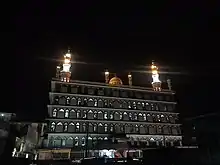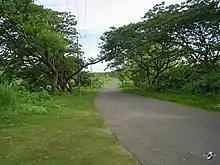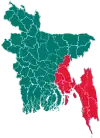Hathazari Upazila
Hathazari (Bengali: হাটহাজারী) is an upazila of Chittagong District in the Division of Chittagong, Bangladesh. Northern Chittagong and Hathazari was formerly ruled by the artistocratic Zamindar family of Ahsanullah Chowdhury. Nawab Haji Abdul Malik Chowdhury Khan Bahadur was the last Zamindar of Hathazari, and the current MP also hails from that family.
Hathazari
হাটহাজারী | |
|---|---|
 Hathazari Location in Bangladesh | |
| Coordinates: 24°54′N 90°52.5′E | |
| Country | |
| Division | Chittagong Division |
| District | Chittagong District |
| Government | |
| • MP (Chittagong-5) | Anisul Islam Mahmud |
| • Upazila Chairman | SM Rashidul Alam |
| Area | |
| • Total | 251.28 km2 (97.02 sq mi) |
| Population (2011) | |
| • Total | 431,748 |
| • Density | 1,700/km2 (4,500/sq mi) |
| Time zone | UTC+6 (BST) |
| Website | http://hathazari.chittagong.gov.bd/ |
Geography
Hathazari is located at 22.5083°N 91.8083°E. It has 52,594 households and a total area of 251.28 km2. The main river is Halda. It is surrounded by Fatikchhari Upazila on the north, Panchlaish Thana and Chandgaon Thana on the south, Raozan Upazila on the east and Sitakunda Upazila on the west.
History
.jpg.webp)
Part of the ancient kingdom of Harikela, 36 thin bull-and-triglyph silver coins were discovered inside a little clay pot in Hathazari's Jobra village in July 1980. All, except one, mentioned the kingdom of Harikela.[1] The Kingdom of Mrauk U built numerous mudforts in present-day Hathazari.[2]
In the fifteenth century, the Sultan of Bengal Shamsuddin Yusuf Shah had a mosque constructed in Dewannagar mouza which is now known as Faqir Mosque. During an expedition against the Arakanese in the early 16th century, Prince Nasiruddin Nasrat Shah passed through the area where he dug a reservoir and built a mosque which still stands today in Chikandandi Union. During the Mughal period, present-day Hathazari was a part of the Aurangabad Pargana. 12 hazaris were appointed to keep law and order and defend the pargana of Aurangabad. Due to Aurangabad being so far away from Murshidabad, the erstwhile capital of the Nawabs of Bengal, the hazaris neglected their duties. The Nawab's representative, Mahasingh, resorted to a ruse to undermine the power of the Hazaris and took the invitation to the Nawab's Kanchari in Sitakunda by cheating with the help of a trick. He was able to betray and capture eight of the twelve Hazaris and send them to Murshidabad. Two of the ten remaining Hazaris surrendered and were excused. The Nawab of Bengal imprisoned the eight Hazaris in iron cages and ordered them to be drowned in the Ganges.[3] One of the excused Hazaris, Bir Singh Hazari, established a haat bazaar in the area and so it came to be known as Hathazari (The haat/market of the Hazari).[4]
Hathazari formed as a thana (police unit) in 1929. The following year, Hathazari was the site of the historic Battle of Jalalabad which took place a few days after the Chittagong armoury raid. It was an encounter which took place between the Bengali revolutionaries led by Surya Sen and Ananta Singh against the British troops. Over 80 British troops and 12 Bengali revolutionaries were killed in the ensuing gunfight in atop the Jalalabad Hills. Sen dispersed his men to neighbouring villages in small groups and thus some escaped though many were arrested.[5] The plan was elaborate and included seizing of arms from the armoury as well as destruction of communication system of the city (including telephone, telegraph and railway), thereby isolating Chittagong from the rest of British Raj.[5]
During the Burma campaign 1944–45, the United States Army Air Forces used the Hathazari Airfield as a supply point and staging airfield for resupply airlift drops over Burma and also as a radio relay station.[6] During the Bangladesh Liberation War of 1971, 11 Bengali freedom fighters were murdered near Nazirhat Bus Stand. The Nobel Prize-recognised Grameen Bank was established in the village of Jobra through a rural banking project there. Hathazari Thana was made an upazila in 1983.[7]
Demographics

According to the 2011 Bangladesh census, Hathazari had a total population of 431,748 with 215,201 Males and 226,547 Females.[8] Most of the people immigrate largely in Saudi Arabia, the United Arab Emirates and other countries in Europe and the Middle East.
Literacy and education

The average literacy rate of Hathazari is 57.9%; with male percentage being 61.1% and female being 54.6%.[7] Al-Jamiatul Ahlia Darul Ulum Moinul Islam, established in 1896, is the oldest and largest Deobandi institution in the country - ranking among the top ten madrasas in the subcontinent.[9] The public research University of Chittagong in Fatehpur was founded in 1966 and is notable for having the largest campus among the universities of Bangladesh. Hathazari Government University College, the Hathazari research and farm-based campus of the Chittagong Veterinary and Animal Sciences University and the Farhadabad High School are also notable educational institutions of Hathazari. The Bangladesh Agricultural Research Institute has a research station in Hathazari.
Administration


Hathazari Upazila is divided into 15 union parishads, further divided into 48 mouzas and 59 villages.[10] The unions are:
- Burirchar
- Chhibatali
- Chikandandi
- South Madarsha
- Dhalai
- Fatehpur
- Forhadabad
- Garduara
- Gumanmardan
- Hathazari
- Mekhal
- Mirzapur
- Nangalmora
- Shikarpur
- North Madarsa
Upazila Chairmen
| Name | Term |
|---|---|
| Syed Wahidul Alam | 25/5/1985-24/5/1990 |
| Muhammad Nurul Amin | 25/5/1990-23/11/1991 |
| Muhammad Ismail | 2009-2014 |
| Mahbubul Alam Chowdhury | 2014-2019 |
| SM Rashidul Alam | 2019-present |
Notable people
- Anisul Islam Mahmud, politician
- Mahbubul Alam, award-winning writer
- M Harun-Ar-Rashid, former Chief of Army Staff
- Muhammad Ibrahim, physician
- Muhammad Faizullah, Islamic speaker
- Muhammad Yunus, Nobel Peace Prize laureate
- Syed Muhammad Ibrahim, former army officer and politician
- Syed Wahidul Alam, politician
References
- M Harunar Rashid (2012). "Harikela". In Islam, Sirajul; Miah, Sajahan; Khanam, Mahfuza; Ahmed, Sabbir (eds.). Banglapedia: the National Encyclopedia of Bangladesh (Online ed.). Dhaka, Bangladesh: Banglapedia Trust, Asiatic Society of Bangladesh. ISBN 984-32-0576-6. OCLC 52727562. Retrieved 23 January 2021.
- Khan, Sadat Ullah (2012). "Arakan". In Islam, Sirajul; Miah, Sajahan; Khanam, Mahfuza; Ahmed, Sabbir (eds.). Banglapedia: the National Encyclopedia of Bangladesh (Online ed.). Dhaka, Bangladesh: Banglapedia Trust, Asiatic Society of Bangladesh. ISBN 984-32-0576-6. OCLC 52727562. Retrieved 23 January 2021.
- "পটভূমি" [Background]. Hathajari Upojela (in Bengali).
- Shamsul Hossain (2012). "Diwan Hat". In Islam, Sirajul; Miah, Sajahan; Khanam, Mahfuza; Ahmed, Sabbir (eds.). Banglapedia: the National Encyclopedia of Bangladesh (Online ed.). Dhaka, Bangladesh: Banglapedia Trust, Asiatic Society of Bangladesh. ISBN 984-32-0576-6. OCLC 52727562. Retrieved 23 January 2021.
- Chandra, Bipan (1989). India's Struggle for Independence: 1857-1947. Penguin Books India. pp. 251–252. ISBN 978-0-14-010781-4.
- Maurer, Maurer (1961). Air Force Combat Units Of World War II. Washington, D.C.: U.S. Government Printing Office. p. 20. OCLC 566017058.
- Sajahan, Syed (2012). "Hathazari Upazila". In Islam, Sirajul; Miah, Sajahan; Khanam, Mahfuza; Ahmed, Sabbir (eds.). Banglapedia: the National Encyclopedia of Bangladesh (Online ed.). Dhaka, Bangladesh: Banglapedia Trust, Asiatic Society of Bangladesh. ISBN 984-32-0576-6. OCLC 52727562. Retrieved 23 January 2021.
- "Population Census Wing, BBS". Archived from the original on 2005-03-27. Retrieved November 10, 2006.
- "NBR Reports" (PDF).
With its impeccable Deobandi credentials, Hathazari madrasa ranks among the top ten madrasas in the subcontinent in terms of its academic standards and reputation.
- "District Statistics 2011: Chittagong" (PDF). Bangladesh Bureau of Statistics. Archived from the original (PDF) on 13 November 2014. Retrieved 14 July 2014.
